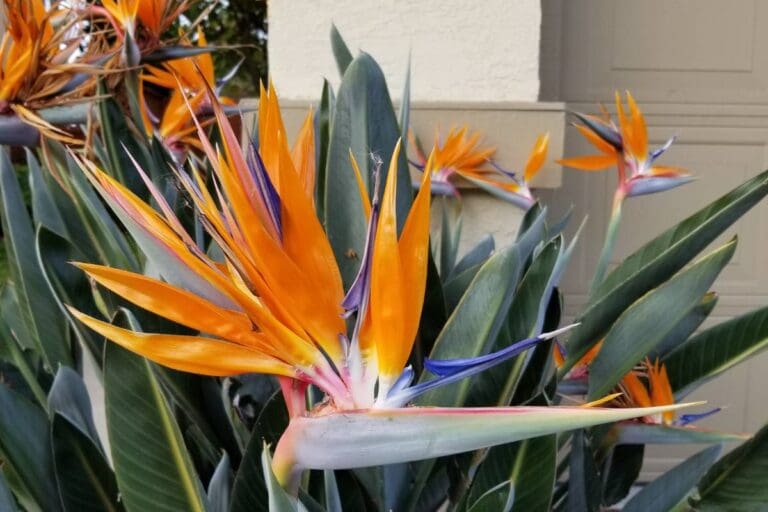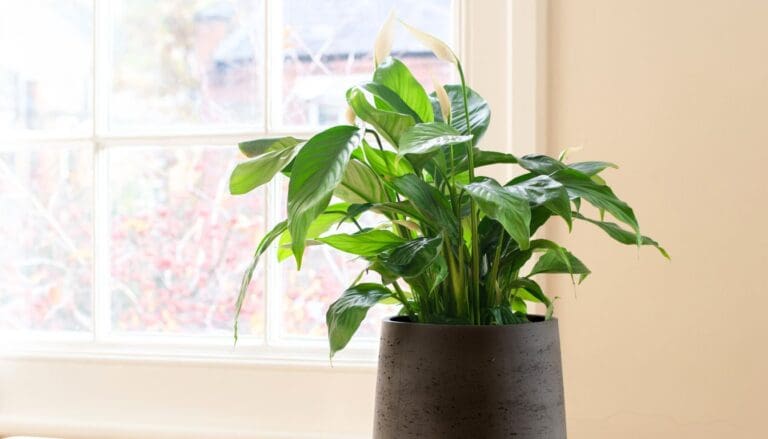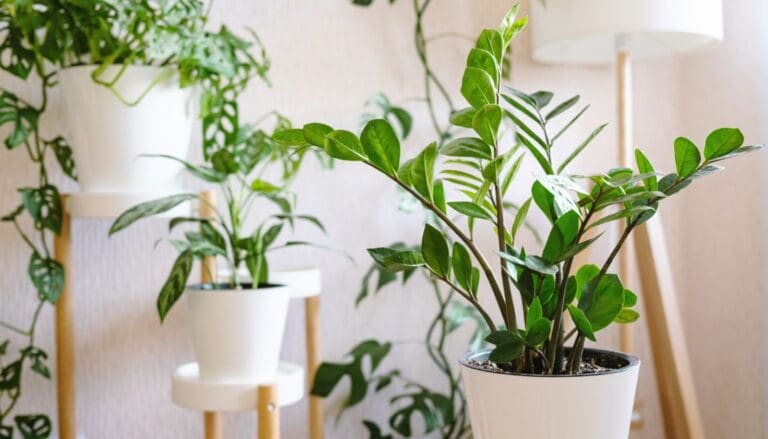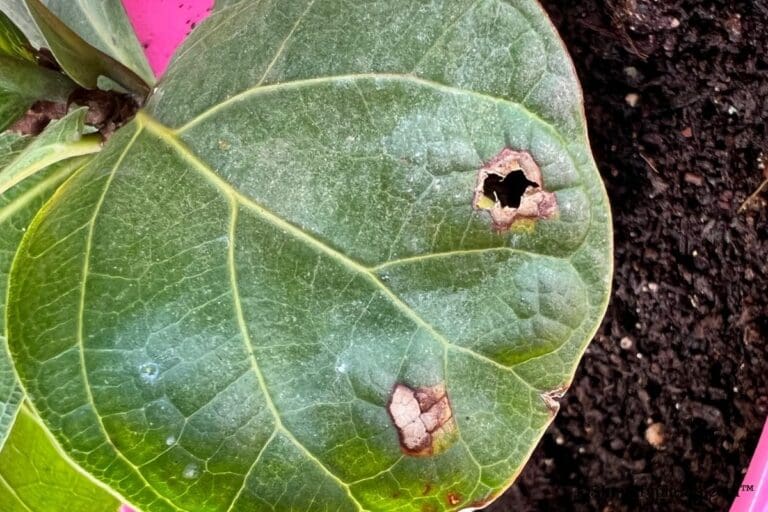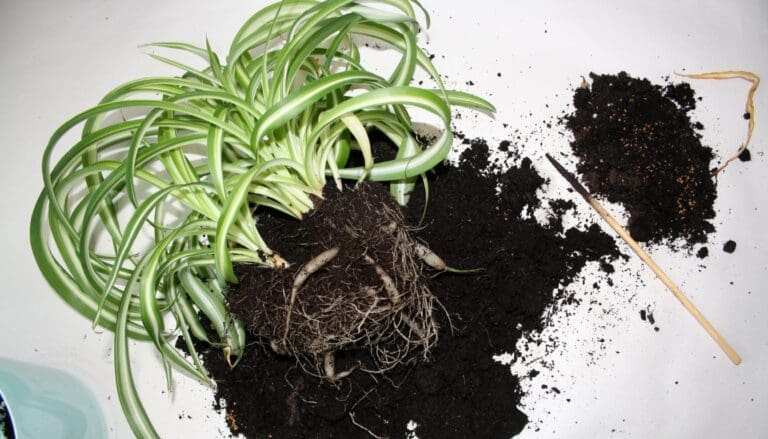Ultimate Care Guide For String of Pearls Plants
String of pearls plants have always struck me as the charming little quirks of the succulent world. I mean, they basically look like a beaded necklace for your windowsill that Mother Nature herself decided to design. 🌱
If you’re browsing through plant shops or scrolling your feeds, and you stumble upon this gem, you might think it’s a high-maintenance diva. But guess what? It’s actually pretty chill if you get to know its simple needs.
Now, if you’ve brought one of these green beauties into your home, you might wonder how you keep those pearly strings plump and happy.
Watering is a bit like a game of ‘Goldilocks and the Three Bears’ — not too much, not too little, but just right. And all that light but not scorching sun can turn into a very real ‘find the sweet spot’ challenge. Sunburned pearls? Definitely not the cute accessory we’re aiming for!
I love sharing the pearls, or in this case, cuts of my plant. Propagation is like that reassuring high-five, letting you know that, hey, you’ve got this gardening thing down!
I just snip a stem, let it callous over for a day or two (you know, to avoid the dreaded rot), and then pop it into some soil that’s as free-draining as my schedule on a lazy Sunday. 😉
So, what’s your string of pearls story? Trying to get those stems to cascade just right? Drop a comment and let’s swap tips and pics!
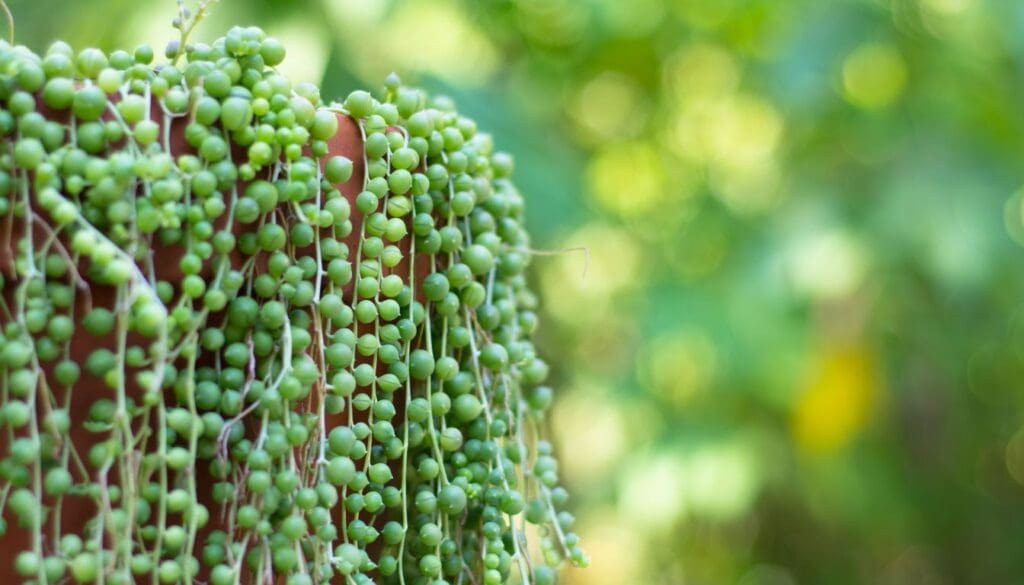
Please note: Simplify Plants is reader-supported. Some links in the post are affiliate links and I get a commission from purchases made through links in the post.
Understanding String of Pearls
I’m so excited to share with you some really cool stuff about the String of Pearls plant! 🌱 Let’s dive right in!
Species Overview
Scientifically known as Senecio rowleyanus, the String of Pearls plant is a succulent that’s sure to add a touch of whimsy to any space. Originating from the dry regions of Southwest Africa, this beauty is part of the Asteraceae family.
Have you ever noticed how its leaves look like little green peas? That’s because they’re meant to conserve water. Clever, right? 💧🌿
Growth Habits
My String of Pearls is a real charmer with its trailing vines that can grow so long they touch the floor! The spheres, or ‘pearls,’ grow on stems that may reach over 2 feet if you give them the love and care they crave.
Can you imagine them spilling dramatically over the edge of a shelf or hanging basket? Just the perfect natural decor, I’d say! 🌟
Keeping paragraphs short and sweet helps, doesn’t it? I find it makes everything a tad easier to follow—and more fun!
Have you grown one of these plants yourself? Let me know in the comments how it’s going! And don’t be shy; hit that share button if you found this snippet helpful!
Ideal Growing Conditions
Let me give you the scoop on creating the perfect environment for your String of Pearls plant. Think of it as setting up a cozy little niche where this gem can happily drape and thrive!
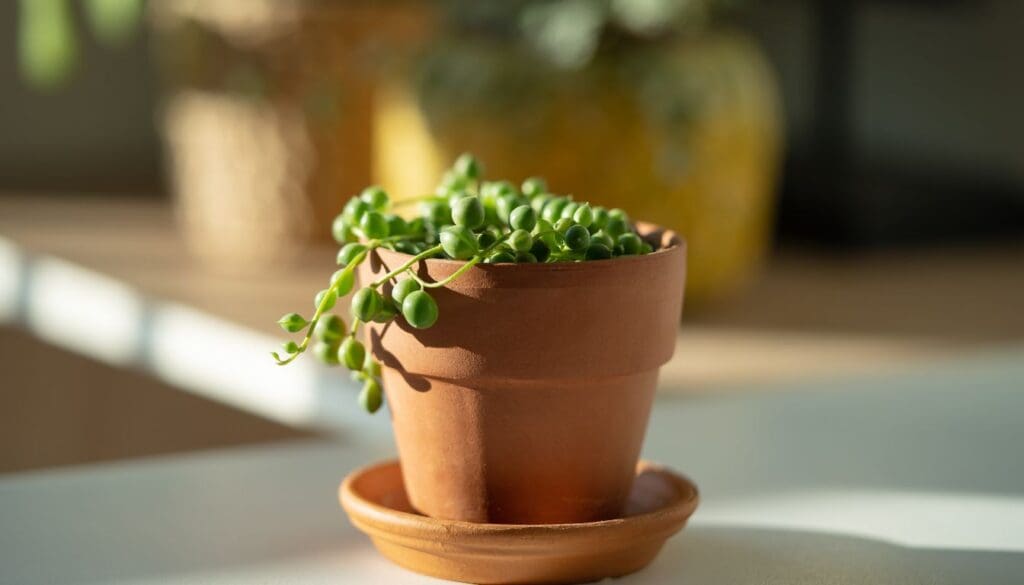
Light Requirements
I’ve learned that bright, indirect light is the sweet spot for the String of Pearls.
Direct sunlight? Nope, it’s a bit too harsh and can fry the delicate leaves. But a nice well-lit room or a spot near a windowsill with a sheer curtain? Perfect! Just remember, these fellows love to bask in light but not sunbathe. 🌞
Temperature and Humidity
Alright, let’s talk temperature. Keeping these beauties in a room between 68 and 72°F (20-22°C) is ideal.
They’re not fond of the cold and definitely won’t appreciate drafts, so keep them away from chilly windows in the winter.
Humidity can be pretty standard – if you’re comfortable, your String of Pearls probably is, too. But if your air is drier than a good sense of humor, consider a light misting every now and then.
Best Soil Mix
Want to know my secret for a happy plant? The soil mix!
For a String of Pearls, you’ll want something that drains like a dream, so think cactus or succulent mix.
I like to jazz mine up with a bit of sand or perlite to keep the roots as dry as my wit. Wet feet? Nope, that’s a no-go for these pearly pals. 🌵
Now, tell me, have you found the perfect spot in your home for these charming beads? I’d love to hear where you’re thinking of placing them or any of your own tips—pop them in the comments below! And if you found this guide helpful, don’t be shy; give it a share!
Planting Your String of Pearls
When I think of the String of Pearls plant, I’m reminded of its quirky charm and how much flair it adds to a space. Isn’t it just the perfect conversation starter? But to get those lovely beads thriving, let’s talk about planting, shall we? 🌱
Pot Selection
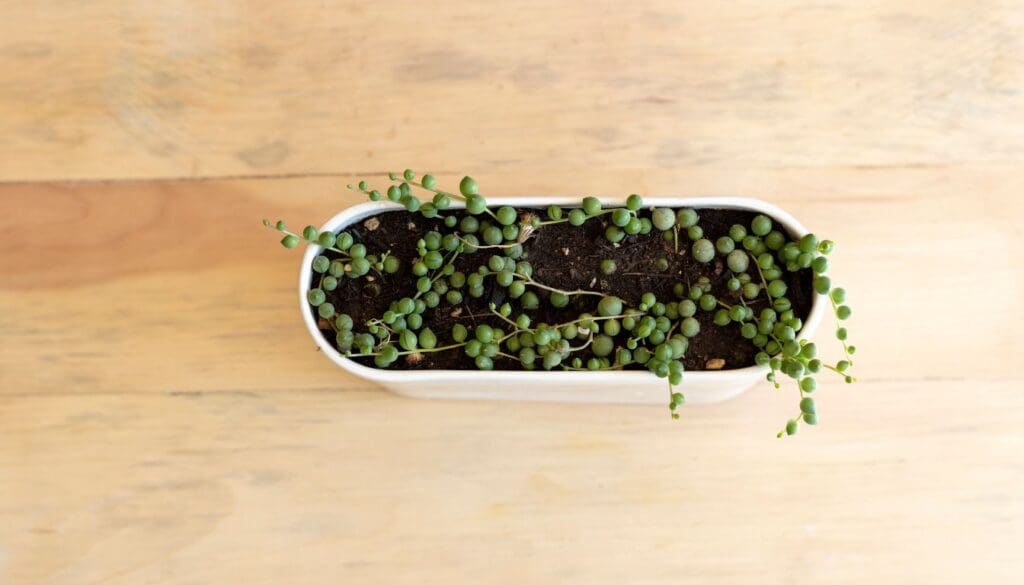
Choosing the right pot for my String of Pearls is crucial – it’s like finding the perfect pair of shoes for a night out!
The pot needs to have drainage holes to avoid waterlogging, which is the nemesis for these succulent beauties.
Ceramic or terracotta pots are my go-to because they’re porous and breathe better than plastic ones, keeping those roots comfy and dry.
A question for you – have you picked out a pot that’s as stylish as your plant? 😏
Planting Process
Now, let’s get our hands dirty – literally! I always start with cactus or succulent soil – it has the perfect balance for drainage and nutrient content. Here are my steps to planting perfection:
- Fill the pot: About a third of the way up with your soil.
- Position the stems: Lay the String of Pearls cuttings on top of the soil, ensuring contact. No need to bury them deep, they like to sit at the soil’s surface.
- Water sparingly: Just enough to moisten the soil. Remember, they hate soggy feet! 💦
Remember, patience is key. It might take a little time for your String of Pearls to settle in and show appreciation for your planting efforts. Have you planted yours yet? If not, what are you waiting for? Share your planting stories below! 🌿✨
Daily Care and Maintenance
Taking care of a String of Pearls plant is like having a quirky little friend who doesn’t ask for much—just your love, some water, and a snack now and then.
Watering Schedule
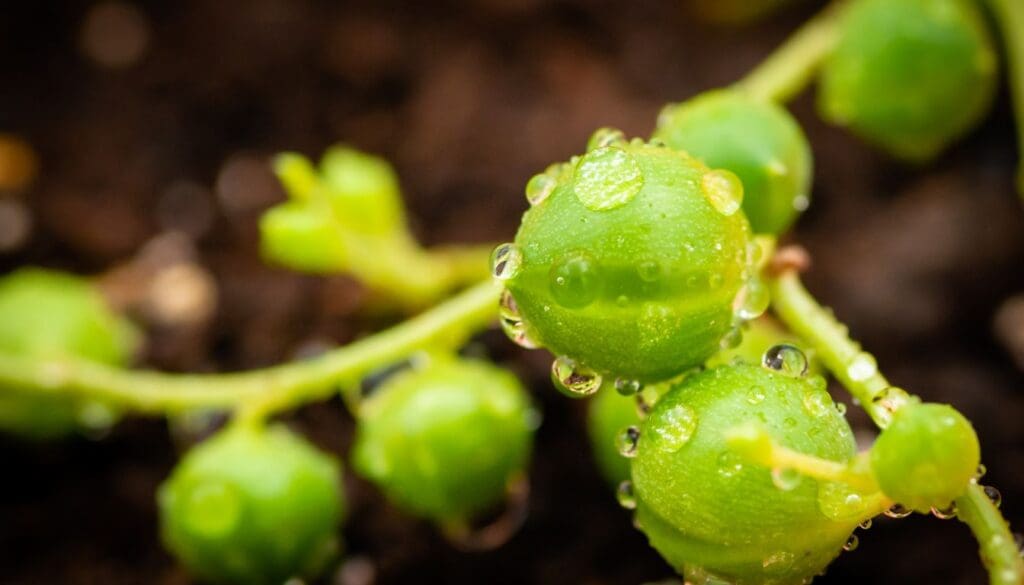
My String of Pearls gets thirsty, but not too thirsty. I stick to a bi-weekly watering schedule, ensuring the soil is completely dry before I give it another drink.
Overwatering is a no-no—it can lead to root rot, and we don’t want that, do we? 😬
Check the soil moisture with your finger—if it’s dry a couple of inches deep, it’s sip time.
Fertilizing Routine
I treat my plant to a light feeding with a cactus or succulent fertilizer during the growing season, March through September.
A half-strength dose once a month keeps my plant happy without overwhelming it.
Remember, too much food and it might just get a tummy ache! Well, not really, but it could harm the plant. 🥄
Pruning and Trimming
I play hairdresser with my String of Pearls every so often, snipping off any dead trails to keep it looking fresh and fabulous.
Pruning also promotes new growth, making it bushier and fuller. Just grab some sterilized scissors, and you’re good to go!
It’s a quick spa treatment that keeps the plant lush and lovely. 💇♂️✂️
Care to share your own String of Pearls stories or ask for advice? Drop a comment below—I’d love to chat plants with you! 🌿💬
Common Issues and Solutions
If you’ve ever found yourself talking to your String of Pearls plant, don’t worry; it’s totally normal…I do it all the time! 🌿
The key things I’ve learned about keeping these succulent beauties happy and healthy involve tackling pests, preventing disease, and solving those pesky growth problems.
Pest Management
Have you noticed any tiny unwanted guests on your String of Pearls? Aphids and mealybugs might crash the party sometimes. 🐛
My go-to move is to mix a teaspoon of insecticidal soap with water and give those pests a gentle shower. For stubborn critters, neem oil is my trusty backup plan!
Disease Prevention
Ugh, plant diseases can be such a downer. To keep your String of Pearls disease-free, ensure your soil is like a free-draining penthouse suite.
Always check the soil’s moisture before giving it a drink. Overwatering is a common mistake—think moist, not a swamp. 🚫💧
Troubleshooting Wilting
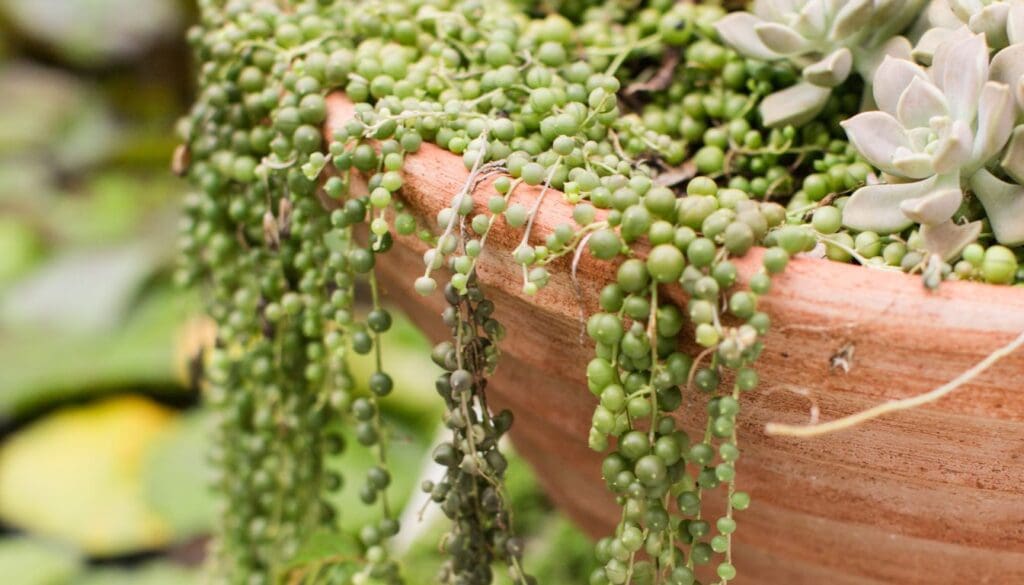
Noticed some limp strands lately? Wilting could be a cry for more water or less sun.
If the soil feels drier than my humor, it’s time to water. And if your plant’s getting more sunlight than a beach bum on vacation, consider moving it to a spot with bright, indirect light. 🌤
Troubleshooting Not Growing
A String of Pearls that’s not growing is like a phone that won’t charge—it’s frustrating!
If it’s just chilling and not spilling, check the temperature. Keep it above 55°F (13°C) and make sure it’s not in a drafty area.
Also, a dose of succulent fertilizer can give it the pep talk it needs. 💬✨
So, have you run into any of these hiccups with your String of Pearls? What tricks have you tried? Drop your tips or questions below and let’s help each other out! And if you found these pointers helpful, share the love with a fellow plant parent. 🌱💚
Propagation Techniques
When I want to expand my succulent collection, propagation is my go-to trick! It’s like a magic show where I turn one plant into many. 🌱✨ Are you ready to try your hand at it?
Cutting Method
I find the Cutting Method super easy and rewarding. Here’s what I do:
- Snip a Healthy Stem: I look for a lively string of pearls stem, about 2-4 inches long, and use clean scissors to make a cut.
- Callous End: Then, I let the cut end dry out for a few days to avoid rot. Patience is key here!
- Plant the Cuttings: Finally, I place the cut end in well-draining soil, like a cactus mix. I make sure to keep the soil a bit moist (not drenched!).
Hey, have you ever tried this? How did it go? I’d love to hear about your experiences in the comments!
Layering Approach
For the Layering Approach, I like to get a bit more strategic:
- Choose Your Branch: I pick a long string of pearls strand and loop it back into the soil where I want it to root.
- Secure the Strand: Using a small piece of wire or a hairpin, I gently fix the strand onto the soil.
- Wait for Magic: In time, roots emerge from the section in contact with the soil, creating a fuller plant.
Isn’t it amazing how you can teach an old plant new tricks? Who’s given this method a try? Share your stories below, and don’t forget to sprinkle a little water fairy dust! 💧✨
Quick Tip: Remember, propagation takes time, so don’t rush your plants. Give them some love, and they’ll return the favor with beautiful new growth!
Have any propagation tales or tips of your own? Drop them in the comments! If you’ve found these tidbits helpful, pass them on to your plant-loving buddies. Happy propagating! 🌿👍
Repotting and Transplanting
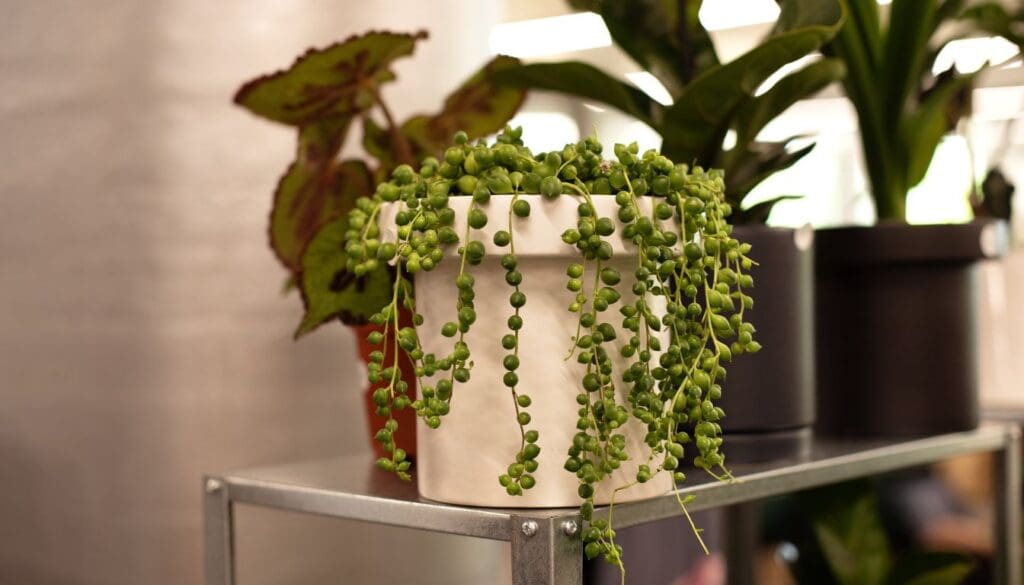
Let me share a couple of savvy tips for giving your String of Pearls the comfiest move to its new abode. Trust me, I’ve got the dirt on how to keep your plant thriving during repot!
When to Repot
So, when should we roll up our sleeves and repot our beaded botanical buddy?
My rule of thumb is to check in on your String of Pearls every couple of years and see if it’s feeling a bit snug in its current home.
If you notice the soil looks worn out or the roots are making a break for it out of the drainage holes, it’s time for a change! 🔄
Repotting Steps
Ready for the big move? Follow these steps to ensure a stress-free transition:
- Choose the right pot: Grab a pot that’s just a smidge larger than the current one. More room for roots means more room for growth!
- Prepare the soil: A mix of cactus and succulent soil works wonders. It’s like a comfy bed for your plant’s roots.
- Gently remove the plant: Wiggle it out and whisper some encouraging words—it helps! 😉
- Place and pack: Set your String of Pearls in the center of the new pot. Tuck it in with soil and pat it gently, like fluffing a pillow.
- Water with care: Give it a modest drink to welcome it to its new home. Avoid a flood—no one likes soggy feet!
Remember, folks, your String of Pearls is your leafy sidekick. So show it love, and don’t hesitate to share your repotting tales or questions in the comments. Have any pearls of wisdom to add? Let’s chat! 💬✨
Decorative Tips and Uses
I just love how the string of pearls plant adds a unique charm to any room! Its cascading vines are perfect for creating that ‘wow’ factor in your home. Let’s get creative with how we show off these beauties!
Display Ideas

Thinking where to place your string of pearls? I’ve got some quirky suggestions! 😄
Why not let them dangle off a high shelf or create a living curtain by hanging multiple plants near a window?
You could even place them in a macramé plant hanger for that boho touch.
Have you tried jazzing up your home office with these trailing wonders? Trust me, they make every Zoom call a bit more fun!
- Shelf showcase: Line them up on a tiered shelf for an impactful display.
- Window wonders: Close to a sunny window – let those pearls glow!
- Vertical vision: On a wall-mounted planter for that green waterfall effect.
And hey, why not get a little unconventional? Ever considered a modern terrarium?
Pop a string of pearls inside and voilà – an instant mini-greenhouse.
Companion Plants
Ooh, now this is where the fun begins! Pairing your string of pearls with other plants can really make them pop.
Succulents with similar light and water needs are your best bet – think echeverias or haworthias. They’ll be like peas in a pod! 🌵✨
- Color contrast: Pair with plants that have darker foliage for a striking visual effect.
- Texture play: Mix with spiky cacti or fluffy moss for a play on textures.
Now it’s your turn! How do you show off your string of pearls? Don’t be shy; drop a comment and let me in on your green-thumb secrets! 🌿💬 Share your stylish setups and inspire our community of plant lovers.
Long-Term Care and Seasonal Adjustments
Ever wonder how to keep your String of Pearls thriving year-round? 🌿 Let’s talk seasonal care:
Spring & Summer:
Ah, the growth seasons! Your plant is a green machine during these warm months.
I give mine bright indirect light and water when the soil is dry to the touch.
Think of it like a nice cool drink on a hot day, right? 🌞
Make sure not to overwater; these succulents prefer a little thirst.
- Water: When soil is dry
- Light: Bright, indirect
Fall & Winter:
Brrr, it’s getting chilly! During the cooler seasons, my String of Pearls enters a rest period. It says, “Slow down, I’m taking a breather!”
So, I back off on the watering, usually to around once a month. 💧 It’s like a little plant hibernation.
- Water: Once a month or less
- Light: Still loves light but it’s okay with shorter days
A little year-round tip:
Keep an eye on your plant’s pearls. If they look shriveled, it might be time for a drink. Plump pearls signal a happy plant!
And don’t forget to dust those pearls occasionally—just like us, they appreciate a good spa day. 😊
Who else chats to their plants, or is it just me? Talk to them. It could be your secret grow-time charm!
Made any seasonal adjustments that your String of Pearls loved? Tell me in the comments! Let’s share and help our green friends live their best plant life! 🌱✨

FAQs and Expert Advice
Today I’m serving up some hot tips on keeping your String of Pearls (a.k.a Curio rowleyanus) looking fabulous! 😎
Let’s jump into the questions you’re dying to ask!
Q: How do I propagate these pearly beauties?
A: It’s easier than making a PB&J! Snip a few stems, about 4-5 inches long. Then, let them have a short chill-out period (a day or two) before you plant. 🌱
Q: What’s the deal with watering?
A: Like a guest who doesn’t overstay their welcome, water sparingly. Wait for the soil to dry out, then give it a good drink. But don’t turn it into a swamp!
Q: Does it need special soil?
A: Indeed! Think of it like a gourmet meal for your plant—a cactus or succulent mix will do wonders. 💫
| Concerns | Solutions |
|---|---|
| Slow Growth | Say hello to sunlight (but not direct!). And offer a diluted dose of cacti food. 🥄 |
| Too Deep in Pot | Keep it perky on a bed of well-draining soil. |
| Pesky Bugs | Show them the door with some insecticide mixed in water. Repeat if they’re extra clingy. |
Are your String of Pearls turning into the crown jewels of your plant collection? Drop a comment below and let me know your secrets!
If you’ve got more burning questions, fire away! 🔥 And remember, sharing is caring – so hit that share button if you found these tips handy! Let’s grow a community of happy plants and happier plant parents! 🌿💚
Recommended Garden Supplies
| Product Image | Our Recommended Gardening Supplies | Check Offers! |
|---|---|---|
Top Top
Top
Top
Top
Top
Top
Top
Top | rePotme Houseplant and Tropical Classic Potting Soil Mix | Check Offer On Amazon |
 Top
Top
Top
Top
Top
Top
Top
Top | Espoma Organic Indoor Plant Food | Check Offer On Amazon |
 Top
Top
Top
Top
Top
Top
Top
Top | GooingTop LED Grow Light 6000K Full Spectrum Clip Plant Growing Lamp | Check Offer On Amazon |
 Top
Top
Top
Top
Top
Top
Top
Top | Soil Moisture Meter | Check Offer On Amazon |
 Top
Top
Top
Top
Top
Top
Top
Top | Govee Hygrometer Thermometer, Bluetooth Enabled! | Check Offer On Amazon |
 Top
Top | LEVOIT Humidifiers for Large Room(Best For Plants) | Check Offer On Amazon |
 Top
Top
Top
Top
Top
Top
Top
Top | Upgraded DIY Automatic Drip Irrigation Kit, 15 Potted Houseplants Support | Check Offer On Amazon |
 Top
Top
Top
Top
Top
Top
Top
Top | Stainless Steel Heavy Duty Gardening Tool Set | Check Offer On Amazon |
 Top
Top
Top
Top
Top
Top
Top
Top | Bonide Insecticidal Soap | Check Offer On Amazon |
 Top
Top
Top
Top
Top
Top
Top
Top | Bonide 32 oz Spray Neem Oil for Organic Gardening | Check Offer On Amazon |
 Top
Top
Top
Top
Top
Top
Top
Top | Garden Safe Fungicide | Check Offer On Amazon |


